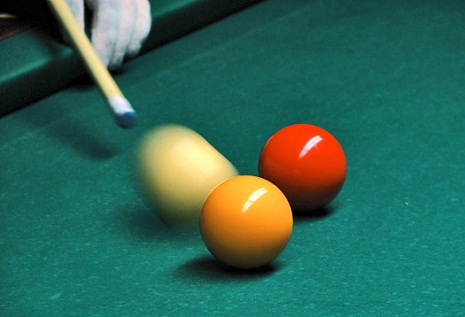NYU (US) — We rely on our visual system more heavily than previously thought in determining the causality of events.
In making judgments about causality, we don’t always need to use cognitive reasoning, researchers have discovered. In some cases, our visual brain—the brain areas that process what the eyes sense—can make these judgments rapidly and automatically.
The study, which appears in Current Biology, “reveals that causality can be computed at an early level in the visual system,” says Martin Rolfs, research fellow in the psychology department.
We frequently make rapid judgments of causality (“The ball knocked the glass off the table”), animacy (“Look out, that thing is alive!”), or intention (“He meant to help her”). These judgments are complex enough that many believe that substantial cognitive reasoning is required—we need our brains to tell us what our eyes have seen.
However, some judgments are so rapid and effortless that they “feel” perceptual—we can make them using only our visual systems, with no thinking required.
It is not yet clear which judgments require significant cognitive processing and which may be mediated solely by our visual system. In the Current Biology study, the researchers investigated one of these—causality judgments—in an effort to better understand the division of labor between visual and cognitive processes.
Their experiments centered on isolating how we perceive causality—i.e., where one event apparently triggers the next. The perception of causality generally involves two components, one that is stimulus based and one that is inference based.
First, to see causal structure between two events, these events need to follow each other with little delay and typically require contact—for instance, a glass immediately falling off a table after being knocked over. This is the stimulus-based component of perceptual causality.
The second component is an inference by which two events are merged into one: rather than seeing one object stopping and a second one starting on its own, there is a continuity of action that is transferred from the first object to the second—just as in billiards where one ball transfers its motion to another ball.
To test how the brain determines causality, the researchers used an “adaptation” procedure that is often employed to uncover neural mechanisms through visual after-effects—changes in what observers see.
The visual system has been shown to quickly change sensitivity to stimuli that are continuously presented: after staring at a red spot continuously, a white wall will appear to have a greenish spot; after seeing a texture moving up continuously, a stationary wall will appear to move down.
Using this adaptation approach in a series of experiments, the researchers found that repeated exposure to the causal events—collisions—test events appeared less causal.
Conversely, adapting to non-causal events had little effect. These findings indicate that certain causal judgments show the classic properties of visual processing (i.e., adaptation) and appear to be determined in the visual system without input from cognition.
Notably, their experimental results showed that the after-effects moved when the eyes moved, just as the green after-image from adapting to red moves when we move our eyes. Only visual and no cognitive processes would show this specificity to eye-centered reference frame.
The finding, the researchers concluded, provides strong evidence that in some cases, the understanding of action—causality, animacy, and intention—is encoded on a perceptual level rather than on a cognitive one.
The EU Seventh Framework Programme, the Deutsche Forschungsgemeinschaft, the German Federal Ministry of Education and Research, and the Agence Nationale de la Recherche Chaire d’Excellence, funded the research.
Source: New York University
More about:
















































